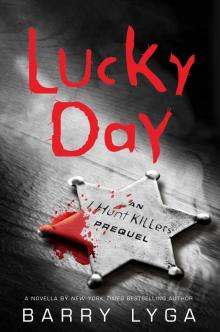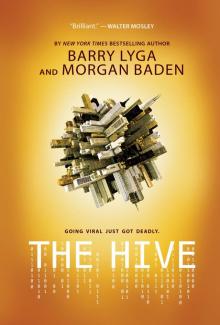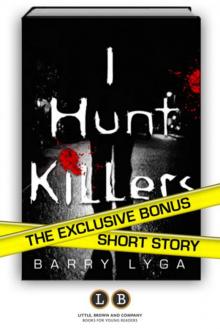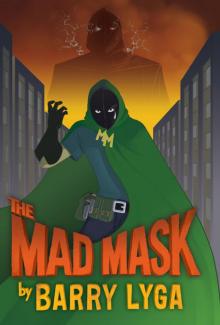- Home
- Barry Lyga
Game Page 7
Game Read online
Page 7
Jazz absorbed that, and then they fell silent and went back to work. The only sounds in the room were pages being turned and the occasional slurping of soda and munching on pizza. Eventually, Connie turned on the TV, occasionally offering an opinion when she heard something interesting.
As the victim count increased, the crimes became more and more violent. Slashing wounds gave way to multiple stab wounds, choking, and—later—disembowelment. The women were raped (in some cases, it appeared, repeatedly). Astonishingly, the killer didn’t always bother with a condom—postmortem examinations had recovered good semen samples from some of the victims. It was possible that the killer used a condom with some victims but not others, though there was no trace of spermicide or lubricant.
“Which means nothing,” Hughes said, “because they make condoms without spermicide or lube. So that doesn’t tell us anything.”
“Any match to the DNA in the system?” Jazz asked. The federal government maintained a database (CODIS) of criminal DNA that state and local authorities used to match up potential suspects. Jazz knew the answer already—if there’d been a match, there would be a name for the Hat-Dog Killer—but he wanted to see how Hughes reacted.
The homicide detective shrugged. “No, but that’s not surprising. This guy is careful. He’s stayed out of the system.”
Realistic. Not flying off the handle or getting depressed. Okay, that was good.
“Are we sure it’s just ‘this guy’? Two carvings, two perps?”
“No. We tossed that one around at first. Thought maybe a copycat. But the second murder had characteristics of the first that never made it into the press. And the DNA evidence doesn’t bear it out.”
Jazz skimmed his screen. “You don’t have DNA from every crime scene.” Contrary to what TV and movies made people believe—and despite Locard’s Exchange Principle—not every crime scene was a vast repository of criminal DNA. Sometimes there was no way to find a DNA specimen. Or to isolate it from others. Sometimes it was just a fluke and there was nothing at all.
“That’s true,” Hughes admitted, “but we do have DNA from a bunch of them, including both Dog and Hat killings. All of the samples match one another, regardless of the kind of killing, regardless of the carving on the body. No tag team. No copycat. Same guy.”
Jazz frowned, studying the file before him. “Well, if you ever have a good suspect and can get a DNA sample from him, you’ll have something to match it against. I see here that he didn’t ejaculate in all the victims….”
“This is disgusting,” Connie said, as if to herself, and turned up the volume slightly. He could almost hear her stomach lurching.
“Mm-hmm,” he agreed. And it was. The photos. The reports. All of it. No doubt about it. But unlike Connie, Jazz only understood that disgust; he didn’t—couldn’t—feel it. Sure, a picture of a human being with its abdomen cut open and its intestines drawn out like pulled taffy was—definitively—disgusting. Grotesque. But Jazz didn’t have a visceral reaction. There was nothing that made him want to stop scrutinizing the pictures. They were photos of dead people in horrific repose and that was that. End of story for Billy Dent’s kid.
“There’s video of the crime scenes, too,” Hughes said, wiping his grease-slick hands on one of the room’s towels. “Want me to load it up on the laptop?”
Cops weren’t particularly bothered by crime scenes, either, Jazz reminded himself, and they weren’t sociopaths. Then again, they had long careers and years of experience to inure them to the horrors of the defiled human body. Jazz had both nature and nurture.
“What are you thinking?” Connie asked. “Do you need to see the video?”
He couldn’t tell her what he’d really been thinking, so he shrugged and waved one of the photos in the air. It was the tenth victim, a woman—Monica Allgood—found near a church in a neighborhood called Park Slope. She’d been raped, slashed across the throat so deeply that her head almost came off, her gut cut open, her intestines piled neatly beside her. A hat had been carved on her forehead.
“Is this when he started paralyzing them?” Jazz asked, brandishing the photo.
Hughes’s jaw dropped. “What did you say?”
“I said, is this when he started paralyzing them? Or, I’m sorry, was I not supposed to figure that part out yet? Did I pass your test, Detective?”
Hughes blushed but had the grace and decency to look Jazz in the eye as he apologized. “I’m sorry. I had to be sure. I deleted the paralysis references from these copies of the reports. He actually started paralyzing with victim eight—Harry Glidden. Guy was a freakin’ tax attorney, can you believe it? Most boring guy in the world, dies like that.” He passed over a sheet of paper. “Here’s the missing deets.”
“You wanted to see if I would pick up on it. That’s okay. I get it.” His respect for Hughes rose a notch. He hoped the detective was returning the favor.
Connie leaned over. “Paralysis?” She stared at the crime-scene photo. “How can you tell? It’s a picture. Nothing moves.”
Hughes didn’t tell Connie to back off, so Jazz let her keep looking over his shoulder. “Void pattern,” he said. A void pattern was an area defined by lack of blood where blood should have spattered… meaning that something had been sitting there at the time of the bloodletting, then moved. In the crime-scene photo, there was a void pattern that outlined a pair of human legs. The victim’s. “In the early crime scenes, there was blood smeared all over the place as he disemboweled them and they thrashed and kicked and fought. But at later scenes, there’s a void pattern instead, indicating that they weren’t moving their legs when they bled out.”
“Maybe he drugged them,” Connie suggested. “Or knocked them out.”
“No. Toxicology shows nothing exotic in their systems. No blunt-force trauma to the head that would indicate a blow strong enough to result in unconsciousness.” Aware of Hughes’s eyes on him, Jazz reconsidered. “Well, no consistent blows to the head. Some of them were hit hard, but not all of them. So I’m saying paralysis. It’s probably not hard, if you know what you’re doing.” He studied the new report for a moment. “ ‘Knife wound at thoracolumbar junction… T-twelve, L-one…’ Slip a knife into the spine, I guess. Right above where the belly button would be from behind.” He twisted to point to the spot on his own back as best he could. “Am I right?” he asked, turning to Hughes.
“Yeah. ME says severed spinal cord at L-one/L-two,” Hughes said. “Damn,” he said, almost involuntarily.
“It’s just a little thing,” Jazz said modestly.
Little things can mean nothin’ or little things can mean everythin’, Dear Old Dad whispered. And the only one who knows for sure is me. Ain’t that special?
“Yeah, but what does it mean?”
“Mean?” Jazz shrugged. “It probably means he was tired of them kicking and getting blood all over the place while he gutted them. Just making his job easier, is all.”
“Just making his job easier?” Hughes blew out a long, exasperated breath, and Jazz finally saw the annoyance and anger that had been lurking under the surface. “Just making his job easier? So I’m looking for a lazy serial killer? Is that it? It just doesn’t make any sense. None of it makes sense.”
It makes sense to us, Billy said. And that’s all that matters. Don’t matter what anyone else thinks.
“It makes perfect sense to him, though,” Jazz said. “It’s probably the only thing in the world that makes sense to him, actually.”
“Look, I could…” Hughes hesitated, as if he knew what he was about to say could be explosive. “I could arrange for you to meet some of the victims’ families. If you want to. If that would help.”
Jazz stared at him far longer than people usually stare. “Why on earth would I want to meet the victims’ families?”
“Sometimes it makes it more real,” Hughes said.
“It’s plenty real. Don’t worry about that.”
The two of them glared at each other until C
onnie cleared her throat and brought them back to the task at hand.
“Not to interrupt this macho stare-down, but I’m wondering… why hats and dogs?” Connie asked. “And why alternate?”
“He doesn’t alternate,” Hughes said quickly. “He did for a while, but if you look at the chart we put together, you can see—”
“He alternates until victim seven,” Jazz said. “He gives her and the next victim hats, then switches back to a dog. Does the same thing later—two hats in a row before a dog.”
“Why?” Connie asked.
“Don’t know.” Jazz leaned back against the headboard, staring up at the ceiling. Hats are for gentlemen, Billy said quietly. My daddy wore a hat every day of his life. Pictures of Jazz’s grandfather floated in his mind’s eye. “Hats are for gentlemen,” he murmured.
“But he put hats on women, too,” Hughes complained.
“Top hats,” Connie specified. She had dragged a chair over and sat with them now, part of the group. “At least, that’s what they look like. They’re actually pretty good. I mean, when you consider they’re being cut into someone’s skin and all.”
“Ever seen prison tats?” Hughes asked, and Jazz’s memory flickered for a moment, remembering the words LOVE and FEAR tattooed across Billy’s knuckles at Wammaket. “A lot of those are done with just a paper clip,” Hughes went on. “Or even a staple. It’s possible to get some real consistent art just with—”
“Hats are for gentlemen,” Jazz said again, interrupting, “and dogs are for…”
“For bitches,” Connie said with finality.
They stared at each other, then over at Hughes.
“No,” the detective said, shaking his head emphatically. “He hatted women and he dogged men. It doesn’t track—”
“It’s not about their actual gender,” Jazz protested. “It’s about how he sees them. It’s about his perception of them. Maybe he decides which they are before he kills them—maybe that’s part of what sets him off. Or maybe he decides based on how they die. How they act. Like this one…” He flipped through data on the tablet. “Look—victim six. A woman. Elana Gibbs. A dog. He raped her, but the ME found less vaginal tearing and fewer bruises than the hat, Marie Leydecker, he raped three weeks later.”
“So if they fight back, they’re a gentleman, and if they don’t they’re a bitch?” Hughes said doubtfully. “You’d think that’s the opposite of how it should be.”
“Yeah, to you,” Jazz said. “To you, it makes sense to go the other way—a woman who fights is a bitch. But what if after that second victim struggled, he learned he liked it? That the resistance arouses him even more? If they struggle, he has an excuse—justification in his mind, a rationale—to hurt them more, to be more violent with them. So they’re giving him what he wants, which makes them gentlemen. Hats.”
Connie shivered next to him. Her face had gone ashy. “I think I’m gonna go get some more ice from the machine. And maybe a Coke. You guys need anything?”
Jazz and Hughes both glanced at the six-pack of Coke Hughes had brought, half of which was still unopened. The three cans sat next to a nearly full bucket of ice.
“That’s a good idea,” Jazz said after a moment. “Stretch your legs, too.”
After the door closed on Connie, Hughes shook his head. “Can she handle this?”
“She’ll be okay.” I hope. “What’s this thing in here on the fourth murder? The bit about a flashing light?”
“Yeah, that’s the only real bit of eyewitness testimony we have. Witness saw a bright flash down on the subway tracks where we later found the body. Thought it was a train at first, but it was coming from the wrong direction.”
“He took a picture….” Jazz mused.
“Yeah, that’s what we think. His trophy.”
“But that doesn’t… that doesn’t quite track.”
“How do you mean?”
“I mean, he already has a trophy. The penises.”
Hughes rubbed his eyes. “He doesn’t always take them. Sometimes he does. Sometimes he doesn’t.”
“Yeah, but…” Jazz frowned. “Why two different trophies? It’s not unheard of, but it has to mean something.”
Hughes took the last piece of pizza. It was cold and stiff, like rigor mortis. “I wish I had more to tell you. But this is why I wanted you involved.”
“I?”
“I. Me. We. Whatever. I was the one who lobbied to bring you in, is all.”
Hughes ate the pizza, chewing with a thoughtful look on his face. “Okay, look, let’s do the rundown one more time. The things we know for sure, all right?” He started ticking facts off on his fingers as he spoke, reciting from memory. “Based on the direction and angle of the slashing wounds, as well as the footprint we found at the third crime scene, he’s between five-ten and six-one, probably something like a hundred ninety, two hundred pounds. He’s right-handed. Most likely white. He’s escalating and he’s smart, so he’s older—mid-thirties. Very organized, so he may be married. Most likely in a stable relationship of some sort. His kill zone seems to be centered on the Red Hook/Carroll Gardens area, but he’s killed as far away as Coney Island. His comfort zone is clearly Brooklyn, which makes him a local. That’s what we know for certain.”
“Wrong,” Jazz said. “Those aren’t things you know for certain. Those are things you think you know for certain. For all we know, those are things he wants you to think you know. Staging the scenes to maximize your confusion. Like here”—he pointed to a photo—“this scene. This murder. He dumps the guts into a KFC bucket. Why do that? Just to mess with you, I guarantee.”
“Or he just likes KFC, ’cause he did the same thing with another one a little while later. Not everything can be faked,” Hughes scoffed.
“Wrong,” Jazz said again, insistent. “Everything and anything can be faked. Billy avoided capture for decades. Every time he killed, some cop somewhere sat down and said, ‘Well, here’s what we know for certain.’ And every time, they were wrong, and Billy lived another day.” Livin’ another day is what it’s all about, Jasper, m’boy, ’cause every day we live is another chance to kill.
Hughes slumped in his chair, defeated. “I’ve spent months chasing this bastard and you’re telling me I’m no closer than the first day.”
“No. I’m just saying you can’t assume you’re any closer. Once you start making assumptions, a guy like this owns you. You were right about one thing: He’s highly organized. But… he’s also picked on some street people—a bunch of homeless, some prostitutes. High-risk victims, if the guy is settled and married like you think.”
“A random middle-class white dude hanging out with homeless people would stick out,” Hughes agreed. “But so far, we don’t have any witnesses. Nothing.”
“You should announce that you do have a witness,” Jazz said. “They almost caught Billy that way once. Cops had nothing, but they leaked to the press that they had an eyewitness and they were closing in. Billy felt like he had to go in and give them some cock-and-bull story about why he was in the area and how he couldn’t have been the killer.”
“What happened?”
Realized it was better to run, Jasper. Billy laughed in his memory. You remember that: Sometimes, the best thing to do is just run. Don’t look back. Don’t look over your shoulder—they’re either there or they’re not, and lookin’ ain’t gonna change that. Run.
“He changed his mind. But it was close.”
“I’ll see what I can do about that. The fake-witness idea. We’ll see.” Hughes stood and stretched.
Jazz took the momentary break to change the subject. “I’ve gotten everything I’m going to get out of papers and screens. I need to see the crime scenes. I need to be where it happened.”
Hughes nodded slowly. “Yeah. Yeah, I know. You have to understand: We have dump sites, but only some of them are also murder scenes.”
Jazz understood. Most crimes had three actual “scenes”—where the crime was planned, wher
e it took place, and where it ended. Sometimes they overlapped.
“And furthermore,” Hughes continued, “a lot of these crimes happened months ago. He’d sometimes go weeks between murders. He’s accelerating.”
“All the more reason—”
“But what I’m saying is, these dump sites were mostly public areas. After we finished up our forensics and everything, we had to turn them back over to the public, you know?”
“I get it. I still need to see them.”
“No problem. I’ll show you everything you need.”
CHAPTER 13
His first big-city crime scene. Maybe it should have been special or memorable somehow, but it was just an alleyway. Nothing remarkable about it. Nothing to distinguish it from any alleyway in any city in any country in the world.
Except that the Hat-Dog Killer had left his first two victims here.
Crime scene meant a lot of things. Technically, it was the place where a crime was committed. But a crime scene doesn’t necessarily mean the only place where a crime was committed. Each individual act of murder could have multiple related crimes: Where the victim was first taken. Where the victim was raped or harmed or injured. Where the victim was actually killed. And where the victim’s body was left. Each one could be a separate scene. Or one scene could combine any or all of them.
Right now, the sun was going down, but the day wasn’t finished blushing, and the alley was cold. Jazz tried to picture it as it had been months ago, in the hottest, dampest days of summer, with the sun gone, the moon high, and the heat rising from the streets in tortuous waves. What had drawn the killer to this alley, to this place behind—what was it called?—Connecticut Bagels? And why, a weirdly nagging part of his brain insisted on wondering, was the place called Connecticut Bagels when it was in New York?
“Two of them here,” he murmured.
They say lightning never strikes twice, Billy’s voice whispered. But that ain’t actually true. It can and it does; that’s science. But not us. We don’t. We don’t drop bodies in the same place. We don’t pick up prospects at the same place. That’s a routine, Jasper. And routines get you killed.

 Lucky Day
Lucky Day Hero-Type
Hero-Type Down Time
Down Time Blood of My Blood
Blood of My Blood Goth Girl Rising
Goth Girl Rising Archvillain
Archvillain Boy Toy
Boy Toy Game
Game Bang
Bang The Legends of Forever
The Legends of Forever The Flash: Green Arrow's Perfect Shot
The Flash: Green Arrow's Perfect Shot The Flash: The Tornado Twins
The Flash: The Tornado Twins Time Will Tell
Time Will Tell The Secret Sea
The Secret Sea The Hive
The Hive Career Day
Career Day MARVEL's Avengers: Infinity War: Thanos
MARVEL's Avengers: Infinity War: Thanos The Mad Mask
The Mad Mask Yesterday Again
Yesterday Again I Hunt Killers
I Hunt Killers Blood Boy
Blood Boy Neutral Mask
Neutral Mask The Astonishing Adventures of Fanboy and Goth Girl
The Astonishing Adventures of Fanboy and Goth Girl I Hunt Killers Neutral Mask
I Hunt Killers Neutral Mask Neutral Mask: an I Hunt Killers prequel
Neutral Mask: an I Hunt Killers prequel Mad Mask
Mad Mask Blood Boy: an I Hunt Killers prequel
Blood Boy: an I Hunt Killers prequel I Hunt Killers Blood Boy
I Hunt Killers Blood Boy The Astonishing Adventures of Fan Boy and Goth Girl
The Astonishing Adventures of Fan Boy and Goth Girl